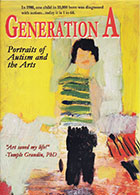
Generation A: Portraits of Autism and the Arts 2014
Distributed by Passion River Films, 154 Mt. Bethel Rd., Warren, NJ 07059; 732-321-0711
Produced by Joanne Lara and Barry Shils
Directed by Barry Shils
DVD, color, 60 min.
Sr. High - General Adult
Autism, Education, Teacher Training
Date Entered: 03/05/2015
Reviewed by Mary Northrup, Metropolitan Community College-Maple Woods, Kansas City, MissouriThis documentary presents an insightful look at the place that the arts play in the education and development of children with autism. These children, their parents, and teachers were filmed at various activities and schools, as well as being interviewed for the camera. Experts in the field – professors, therapists, a psychiatrist, owners and founders of organizations and activities – provide expert commentary. Temple Grandin, probably the most famous autistic person and crusader, talks about her experiences growing up. She advocates for what is needed to help autistic children and get them into jobs. Actor Ed Asner, who has relatives who are autistic, makes an appearance, too, speaking at an event where autistic kids perform.
A variety of activities make up “the arts” of the title. Movement/dance, art, media, music, and even equestrian therapy are showcased. The film captures the frustration of some of the children, but it also shows phenomenal successes. Examples include several young people who have created animated films and who have performed musically. The film also tackles special topics, such as the use of medications and a dual diagnosis (autism plus cerebral palsy).
The film moves along quickly, with a good mixture of facts and personal stories. Diversity in race and age is in evidence. Viewers will learn the criteria of autism, how it affects language and socialization, repetitive behaviors in the autistic person, many of the therapies available, and the autistic child’s life in his or her own words.
College students taking courses in education, special education, psychology, child development, art therapy, or music therapy will find this documentary interesting. Parents of autistic children could also use it as a resource for various therapies and approaches. Therefore, it would be appropriate for both academic libraries and public libraries.
This film brings home the power of art. Important for all children and in all schools, the arts can be especially important to autistic children and, in some cases, may be lifesavers.